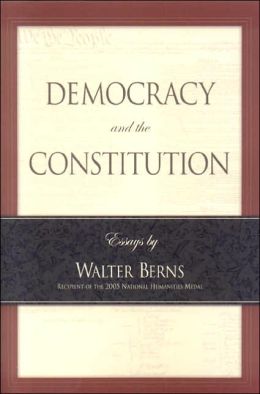AEI Press, 2006.
Excerpt:
One of the distinctive things about America is that its Founders were political theorists as well as practitioners. Consider, as the most telling example, the Declaration of Independence. It was drafted by Thomas Jefferson, John Adams, and Benjamin Franklin, men who had distinguished political careers, but who also wrote books and scientific papers and founded universities (Jefferson the University of Virginia and Franklin the Philadelphia Academy, which became the University of Pennsylvania). Franklin was also one of the founders of our first so-called learned society (the American Philosophical Society), and Jefferson served as one of its first presidents. As for James Madison, Alexander Hamilton, and John Jay, they combined under the pseudonym of Publius to write The Federalist (or Federalist Papers), which has been described in our own time as “the most important work in political science that has ever been written, or is likely ever to be written, in the United States.”
Not only were they all political theorists, but they were completely confident of the theory they espoused. “We hold these truths to be self-evident,” they declared in 1776, that all men are equally endowed with certain unalienable rights, and that government is instituted “to secure these rights.” They believed it important that students, specifically university students, receive instruction in these matters. Accordingly, when designing the curriculum for his University of Virginia, Jefferson proposed that students be thoroughly schooled in “the general principles of liberty and the rights of man, in nature and in society.” To this end, he recommended, among the books to be read, John Locke’s treatises of government, and, of course, the Declaration of Independence, The Federalist, and the Constitution. Who better to assign this reading than professors of political science? At any rate, I thought it appropriate to devote a good portion of my time in the classroom to expounding and defending the principles of liberal democracy and the institutions embodying it here in the United States.
Table of Contents
INTRODUCTION
PART I. CONSTITUTIONALISM
PREFACE
1. ANCIENTS AND MODERNS: THE EMERGENCE OF MODERN CONSTITUTIONALISM
2. THE ILLEGITIMACY OF APPEALS TO NATURAL LAW IN CONSTITUTIONAL INTERPRETATION
3. PRESERVING A LIVING CONSTITUTION
First Invocation of Extraconstitutional Principles
“Natural Justice”
The Authority of Judges
The Failure of Congress
The Death of Constitutionalism
Legitimacy and Authority
4. THE DEMISE OF THE CONSTITUTION
5. SOLVING THE PROBLEM OF DEMOCRACY
America’s Good Fortune
Principles of Government
A Republican Government
The Model of John Locke
The Role of the Judiciary
A Republican Constitution
A Model Constitution
6. CONSTITUTIONALISM AND MULTICULTURALISM
PART II. CONSTITUTIONAL AND POLITICAL MATTERS
PREFACE
1. STATES’ RIGHTS AND THE UNION
2. TALKERS
4. TWO-AND-A-HALF CHEERS FOR THE ELECTORAL COLLEGE
6. FLAG-BURNING AND OTHER MODES OF EXPRESSION
7. BLUE MOVIES
10. RELIGION AND THE DEATH PENALTY
11. UNDER GOD
12. WHAT DOES THE CONSTITUTION EXPECT OF JEWS?
PART III. ACADEMIC MATTERS
PREFACE
1. THE ASSAULT ON THE UNIVERSITIES: THEN AND NOW
PART IV. ADDENDUM: PERSONAL MATTERS
PREFACE
Online:
American Enterprise Institute
Amazon

